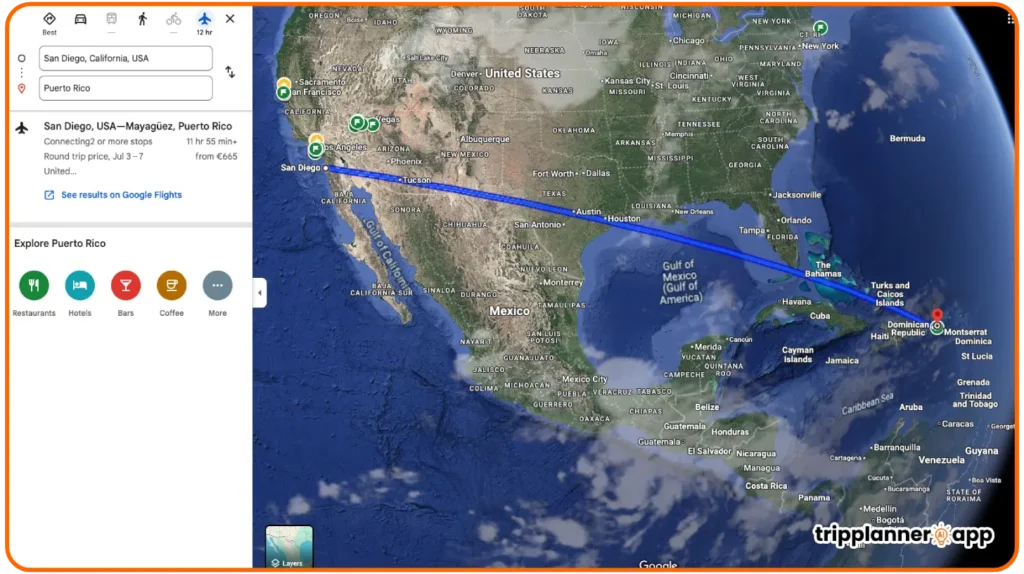Imagine booking a flight and arranging your entire itinerary in just a few clicks. With the integration of AI into travel planning, this concept is rapidly becoming a reality. Google Flights stands at the forefront of this revolution, combining cutting-edge technology with user-centric features to transform traditional travel planning into a seamless and intuitive experience. Let’s delve deeper into the advantages Google Flights brings to AI-driven trip itineraries.
Introduction
In today’s fast-paced world, Google Flights offers a streamlined solution for travel booking with its advanced features and integration capabilities. Designed to cater to the needs of modern travelers, it provides real-time data and dynamic options for anyone looking to make their travel planning as efficient as possible. As we explore the specific features of Google Flights, you’ll discover how it simplifies itinerary planning and enhances overall travel effectiveness.
What is Google Flights and why is it crucial for trip planning?
Google Flights is an advanced flight booking platform that not only compares prices across airlines but also curates the best travel itineraries based on user preferences. Its standout ability is providing up-to-date prices and availability, helping users to make informed decisions quickly. Here are some of the crucial reasons why Google Flights is integral to the modern travel landscape:
- Real-Time Updates: Unlike traditional booking platforms, Google Flights offers real-time updates on flight pricing and availability. This ensures travelers can seize the best deals as they appear, without delay.
- Comprehensive Search: Users can search across multiple airlines and filter based on their preferences like layovers, travel time, and airline alliances.
- Flexibility: Google Flights provides flexible date searches that showcase price changes over a given period, aiding in selecting optimal travel dates.
- Integration with AI Tools: The platform smoothly integrates with AI-driven travel tools, allowing for dynamic trip planning that evolves with changing prices and user preferences.
The inclusion of these features makes Google Flights not just a tool for buying tickets but a comprehensive platform for devising entire travel itineraries that align with personal and professional schedules.
The role of flight search in AI-generated itineraries
Flight search capabilities are essential in AI-generated itineraries, with platforms like Google Flights playing a pivotal role. These tools gather extensive flight and market data to create personalized travel plans that reflect the best options for users.
A few key roles these searches serve include:
- Data Aggregation: Platforms aggregate flight data from a variety of airlines and third-party sites, ensuring users receive a wide spectrum of options.
- Custom Recommendations: AI-powered tools analyze historical booking behaviors and user preferences to tailor flight options that match individuals’ needs.
- Schedule Optimization: AI-generated itineraries consider countless variables, like layovers and travel duration, to present the most time-efficient travel paths.
The synergy between AI and flight search enables travelers to transition seamlessly from the planning phase to the execution of their trips, maximizing convenience and minimizing hassle.
How Google Flights complements trip planner AI tools
Google Flights enhances the effectiveness of trip planner AI tools through several unique integrations and features. Here is why it is indispensable:
- Dynamic Data Feed: Google Flights offers a robust API that AI trip planners can connect to, enabling constant updates to itineraries as flight availability and pricing change.
- Price Insight Tools: With the use of predictive pricing algorithms, AI tools help travelers understand the market trends, allowing them to book flights financially and strategically.
- Integrated Itinerary Features: Users can merge flight bookings with their personal calendars via Google services to optimize scheduling and receive timely notifications.
These aspects make Google Flights an essential resource for AI trip planners, ensuring that users receive adaptive, real-time travel plans.
Key features that enhance travel planning
When planning a trip, having access to flexible and detailed tools is critical. Google Flights provides an array of features that cater to this need, offering real-time updates, flexible date searches, and the ability to set fare alerts among others. These options are designed to enrich the travel planning process, ensuring smoother, hassle-free journeys.
Real-time flight search and pricing
Incorporating real-time data is a core strength of Google Flights, making it invaluable for anyone booking travel. Benefits include:
- Instant Fare Updates: Travelers receive real-time updates on pricing, preventing outdated fare issues common with other platforms.
- Availability Checks: With rapid processing capabilities, users can confidently secure their spots on flights without encountering sold-out errors post-search.
Google Flights ensures users remain informed of their options, thus streamlining decision-making processes when booking travel.
Flexible date & destination exploration
Google Flights shines with its flexible date and destination exploration capabilities. Here’s how it enhances your travel planning:
- Date Grid & Calendar View: Check flight prices for multiple dates with ease, allowing you to shift dates to take advantage of cheaper options.
- Destination Exploration: If you’re flexible with where to go, Google Flights allows broad searches to any destination, helping identify affordable travel routes.
This flexibility means you no longer have to stick to rigid plans, as you can adjust based on what’s most affordable.
Price graphs, trends, and fare alerts
The ability to visualize and predict airfare fluctuations through Google Flights’ price graphs is a standout feature:
- Trends Visualization: By examining historical data and fare trends, users can better gauge when to book for optimal pricing.
- Fare Alerts: Enable alerts to stay informed of significant fare changes, optimizing purchase timing.
This predictive analytic capability is a game-changer for travelers looking to capitalize on the best deals.
Filters: stopovers, duration, airlines, and baggage options
Tailoring flights according to specific criteria is hassle-free with Google Flights. It offers comprehensive filters to narrow down results:
- Stopover Preferences: Select non-stop flights or limit stopovers based on personal convenience.
- Duration and Airlines: Adjust preferences to find airlines and routes that offer desired travel times or loyalty benefits.
- Baggage Policies: Avoid unexpected fees by filtering results that align with baggage needs.
These features simplify customizing search results, ensuring your travel arrangements perfectly match your expectations.
Multi-city and round-the-world trip support
Google Flights excels in planning complex itineraries through its multi-city and round-the-world search capabilities:
- Multi-city Booking: Combine multiple destinations into one booking process, reducing logistical strain.
- Round-the-world Routing: Plan global adventures with integrated route mapping and fare optimization strategies.
This support lets you focus on exploring rather than worrying about the logistics of planning an extended journey.
Read reviews of other AI trip planners and support tools to help you plan smarter.
EasyTrip AI: Transform Travel Planning with Personalized Itineraries
EasyTrip AI is reshaping the future of travel planning with its sophisticated AI-powered itinerary planning capabilities. In a world where personalized experiences are valued over standard travel packages, EasyTrip AI [...]
How Google Flights supports AI trip planner tools
The advanced features of Google Flights bridge essential data gaps for AI trip planners. This synergy allows for the crafting of personalized journeys, ensuring timing, pricing, and logistics are harmoniously aligned.
Verifying AI-suggested routes for feasibility
AI-generated itineraries can benefit from the rigorous data accuracy Google Flights provides:
- Cross-Verification: Double-check AI-generated plans against live data to ensure feasibility and cost-effectiveness.
- Feasibility Checks: Adjust AI plans automatically to accommodate real-time changes or unforeseen disruptions through Google Flights.
These checks maintain itinerary integrity, assuring travelers their plans are both viable and achievable in real life.
Enhancing budget planning with real-time fare data
Budgeting becomes simplified and more precise with the integration of Google Flights:
- Fare Comparisons: Instantly assess current prices alongside historical data to identify savings opportunities.
- Alerts for Budget Travel: Receive timely notifications on price drops, maximizing cost-saving options.
This feature empowers budget-conscious travelers to optimize their spending without compromising travel quality.
Filling gaps: matching flights to AI itinerary timelines
Maintaining a synchronized itinerary is crucial, and Google Flights ensures your AI plans align seamlessly:
- Schedule Harmony: Match flights with specific itinerary activities, avoiding overlapping or conflicting schedules.
- Real-time Updates: Immediate notifications about schedule changes ensure travelers stay informed and in control.
This synchronization minimizes potential travel disruptions, enhancing the overall travel experience.
Integrating with calendar and booking apps
Google Flights integrates smoothly with digital calendars and booking systems, amplifying its utility:
- Calendar Synchronization: Seamlessly export key travel dates and information to personal calendars for constant oversight.
- Booking Seamlessness: Leverage integrations to facilitate one-click bookings without leaving your standard workflow.
This dual integration simplifies travel planning, making itinerary management efficient and straightforward.
Use cases in AI trip planning
Harnessing the features of Google Flights in conjunction with AI trip planners further enhances the travel process by providing intelligent prompts and adaptable itineraries for savvy travelers.
Smart prompting: “Find me the cheapest flight matching this itinerary”
One of the prominent features of integrating Google Flights with AI tools is smart prompting, offering users a refined search based on personalized inputs:
- Tailored Suggestions: AI scans historical data and provides specific travel suggestions that align with user preferences.
- Instant Matching: Link your itinerary details with Google Flights to receive prompt flight options that match your plans.
This tailored approach ensures more effective and relevant travel suggestions, enhancing the booking process.
Dynamic re-routing: adjusting trips based on price alerts
Reactive adjustments through dynamic re-routing present travelers with further opportunities:
- Real-time Adaptability: Be alerted to fare adjustments that allow itinerary re-optimization for cost or convenience improvements.
- Route Flexibility: Modify travel paths to incorporate newly discovered, more cost-effective routes.
Such features are particularly beneficial for flexible travelers who can adapt rapidly to maximize savings.
Time optimization: choosing flights that match planned activities
Efficient time management is at the core of effective travel planning:
- Activity Alignment: Schedule flights in harmony with pre-arranged activities, minimizing disruptions and maximizing enjoyment.
- Reduced Downtime: Choose flights that minimize wait times while optimizing time at the destination.
This synchronization can preserve energy, allowing travelers to fully engage with experiences without excessive transit-induced fatigue.
Generating flight segments for multi-destination itineraries
AI trip planners enhanced with Google Flights’ capabilities help visualize complex itineraries effortlessly:
- Segmented Travel Plans: Split travels into efficient flight segments, balancing cost, convenience, and time.
- Integrated Global Travel: Plan paths that span multiple continents with the inclusion of insightful route suggestions.
This feature is invaluable for explorers eager to maximize their experience across multiple destinations with minimal logistical headaches.
Benefits and limitations
Understanding the benefits and limitations associated with Google Flights is essential for a comprehensive planning strategy, helping users effectively leverage the platform while being mindful of its potential shortcomings.
Benefits: speed, flexibility, transparency, broad search coverage
Google Flights offers considerable strengths, addressing user needs from multiple angles:
- Speed: Rapid processing reduces time-consuming searches.
- Flexibility: Date and destination flexibility adapts trips to user preferences.
- Transparency: Clear data presentation aids in informed decision-making.
- Broad Coverage: Extensive search capabilities ensure comprehensive options, barring a few limitations.
Such benefits underscore Google Flights as a reliable ally for travelers, balancing convenience with comprehensive data access.
Limitations: doesn’t always show budget airline fares or bundles
While Google Flights covers a broad spectrum, it has its limitations:
- Limited Low-Cost Carrier Access: Misses certain budget airline fares, necessitating supplemental searches.
- Bundled Services: Does not always present package deals, which can be a drawback for some users seeking all-in-one solutions.
Recognizing these gaps enables travelers to strategize effectively, supplementing Google Flights with additional tools as needed.
No direct booking – requires external follow-through
An essential consideration for Google Flights users is the platform’s follow-through requirements:
- External Bookings: Completing purchases via third-party sites can introduce delays or confusion.
- Cross-Site Coordination: Users must transition between platforms, which could disrupt the booking flow.
Understanding these nuances helps travelers to plan effectively, managing expectations related to booking procedures.
Tips for using Google Flights with AI trip tools
The intersection of Google Flights and AI trip tools offers vast potentials. By implementing adaptable strategies, users can exploit the best each tool has to offer, from optimized scheduling to notification insights.
Use fare tracking to anticipate price drops
Optimizing your travel budget becomes feasible by utilizing Google Flights’ fare tracking:
- Alert Measures: Engage with email alerts to catch significant price shifts as they occur.
- Timing Insights: Recognize pricing patterns and align purchasing decisions with the most cost-effective periods.
Taking advantage of these functions aids in securing the best travel deals through informed, timely actions.
Export or screenshot results for trip builder input
Travel planning benefits from systematic organization and data retention:
- Manual Capture: Screenshot relevant results for itinerary builders, creating tangible records for reference.
- Direct Export: Use available features to export flight data seamlessly across planning tools.
Effective data capture aids in creating coherent, well-structured travel itineraries for both standalone trips and components of larger plans.
Use explore map for last-minute or spontaneous trips
The Explore feature on Google Flights caters to the adventurous spirit:
- Spontaneous Searching: Discover available travel options without predefined destinations, igniting inspiration for impromptu voyages.
- Visual Mapping: Navigate potential destinations via intuitive map interfaces, ensuring alignment with budget preferences.
This fosters serendipitous travel by exposing travelers to opportunities they might not have previously considered.
Combine with Google Calendar or Gmail for trip sync
Streamlining travel plans with digital tools enhances organization:
- Calendar Integration: Sync flight data with Google Calendar for consistent reminders and updates.
- Email Coordination: Consolidate booking confirmations with Gmail, reducing missed notifications and travel errors.
Such integrations ensure travelers remain informed, facilitating stress-free journeys through well-coordinated planning.
Final thoughts
The intersection of Google Flights with AI trip planners depicts a transformative era in travel arrangements. By harnessing expansive datasets and adaptive algorithms, these tools present an unprecedented opportunity for travelers to turn potential travel chaos into organized departures and arrivals.
The revolution in travel planning is underscored by AI’s role in transforming data consumption, enriching the array of options and personalization available to users. As technology continues to evolve, these tools promise to reshape travel experiences, ensuring travelers are prepared, informed, and empowered at every step of their journey.
Concluding Thoughts: By understanding the capabilities and limitations of Google Flights and AI trip planners, travelers can make informed decisions that enhance their travel experiences. The future of travel is undoubtedly becoming more digitized and interconnected, offering travelers unprecedented control over every aspect of their journey. Whether optimizing fare savings or ensuring seamless calendar synchronization, these innovations promise a future where travel planning is as exciting and effortless as the trips themselves.
Still Looking for the Perfect AI Trip Planner?
Discover all the best AI-powered trip planning tools in one place. Whether you need a fast itinerary builder, a chat-based assistant, or a browser extension — we’ve got you covered!
Browse All AI Trip Planners





